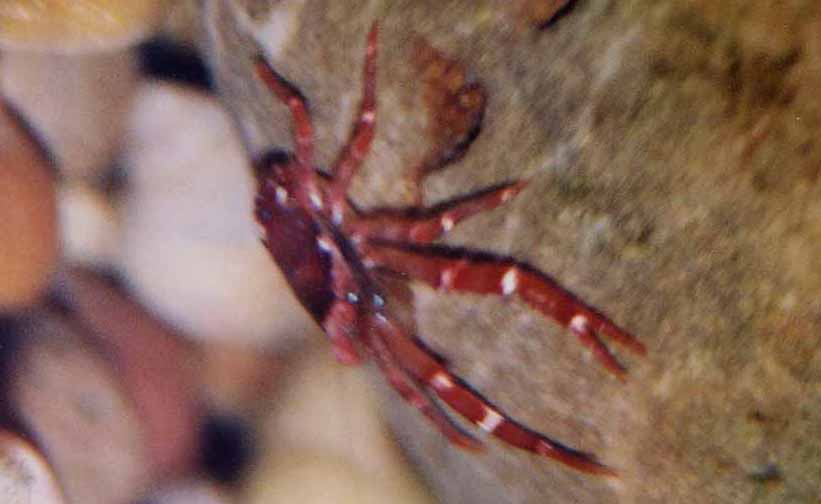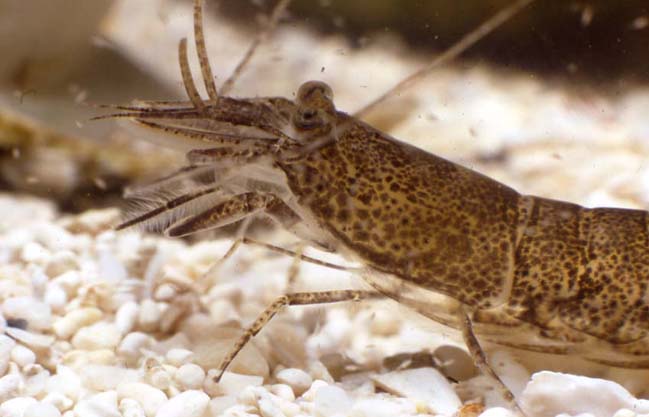

|
Study Society |
British Marine
Wildlife Photographs 1998
British
Marine Life Study Society Portfolio
Crustacea
II
|
|
|
|
|
|
 |
 |
|
|
|
PRAWNS AND SHRIMPS
A long-handled prawn or pond net dipped into a rock pool at mid-tide level or below, or edged around the weedy surrounds of a pool, is likely to catch a jumping mass of prawns of different sizes. Crabs will grapple with both the inside and the outside of the net, and on many of the British shores small fish like young wrasse will almost certainly be caught, but they are likely to be far outnumbered by prawns.
Is it a Prawn or a Shrimp?
Alas, there is no absolutely correct answer. In common usage the names are interchangeable, and there are lots of prawn-like or shrimp-like animals to confuse the novice rockpooler. Marine biologists will use the scientific names.
However, the casual rockpooler wanting to put a name to what he finds can follow the terms used for British species only:
The Prawn is transparent with long legs and is found amongst the weed in rock pools on the shore. There are several different species. In the south and west the species in the pools are called by the scientific name of Palaemon.
The Shrimp is the sandy coloured crustacean that lives in the
sandy shallows. It has short legs and buries itself in the sand. It is
called by the scientific name of Crangon
and is found all around the British coast.
shrimp
1. a. Any of the slender, long-tailed, long-legged
(chiefly marine) crustaceans of the genus Crangon and allied genera, closely
related to the prawns; esp. C. vulgaris, the common shrimp, which inhabits
the sand on the coasts of Great Britain and is a common article of food.
Also, in a wider sense, applied to various
similar crustaceans, as the families Mysidæ and Gammaridæ;
see brine, fairy, opossum shrimp, etc.
1327 Wardrobe Acc. 20 Edw. II, 31/18 Shrimpis, 3d. c1430 Two Cookery-bks. 42 Take e Luce, an e Perche, & e Schrympe, & see hem. c1440 Promp. Parv. 449/1 Schrymp, fysche, stingus. c1450 Brut 447 Grete Scrymppys. c1460 J. RUSSELL Bk. Nurture 646 in Babees Bk., Shrympes welle pyked e scales awey ye cast. 1553 BELON De Aquatilibus 273 Anglorum..pisces ex Tamesi & aliis Britanniæ fluminibus..Roches, Daces, Tenche, Ruff, Schriemp, Prans. 1622 DRAYTON Poly-olb. xxv. 190 The Periwincle, Prawne, the Cockle, and the Shrimpe, For wanton womens tasts, or for weake stomacks bought. 1674 FLATMAN Belly God 97 An ore-charg'd Stomack roasted shrimps will ease. 1770 P. PITTMAN Europ. Settlem. 5 Shrimps are found in the Mississippi as far as Natches. 1802 BINGLEY Zool. (1813) III. 389 The Shrimp is much smaller than the Prawn, and is by no means so much esteemed as food. 1848 DICKENS Dombey vi, She partook of shrimps and porter. 1890 Hardwicke's Sci. Gossip XXVI. 280/1 The phantom shrimp (Caprella linearis) of S. Australia.
prawn
1. a. Any of various edible marine decapod
crustaceans resembling shrimps but usually somewhat larger and with a prominent
rostrum on the carapace. Also more widely: a large shrimp.
The traditional edible prawns of the North
Atlantic belong to the genus Leander (infraorder Caridea), while those
of Indo-Pacific origin belong to the genus Penaeus (suborder Dendrobranchiata).
Dublin Bay, mud-, tiger prawn: see the
first element.
1336 in C. M. Woolgar Househ. Accts. Medieval Eng. (1992) I. 184 In codling et merling vii d. Item in buttis iii d. In pranes iii..d. 1426 Maldon (Essex) Court Rolls (Bundle 16, m. 2v), Item, dicunt qd Margareta vxor Robti Seyken forstallauit in foro praynes qu..emit in foro de Iohanne Gyrlfader, &c., ideo in misericordia vj d. c1475 Gregory's Chron. in J. Gairdner Hist. Coll. Citizen London (1876) 141 Porpys rostyd, eneuse fryde, crevys of douce, datys, pranys, rede schry[m]ppys. a1529 J. SKELTON Collyn Clout (1545) 209 Ye pycke no shrympes nor pranes. 1600 SHAKESPEARE Henry IV, Pt. 2 II. i. 98 Telling vs she had a good dish of prawnes. 1620 T. VENNER Via Recta iv. 79 Pranes and Shrimps are of one and the same nature. 1740 R. BROOKES Art of Angling, Rock & Sea-fishing II. lxxxiv. 212 The Prawn..and the Shrimp..harbour themselves in the Holes of Rocks, and such-like Places along the Sea-Coast. 1788 LD. AUCKLAND Corr. (1861) II. 93 Within an ace of being laid low among the prawns, pebbles, and porpoises. 1813 W. BINGLEY Animal Biogr. (ed. 4) III. 389 The Shrimp is much smaller than the Prawn, and is by no means so much esteemed as food. 1841 DICKENS Old Curiosity Shop I. v. 105 He..devoured gigantic prawns with the heads and tails on. 1893 T. R. R. STEBBING Hist. Crustacea xvi. 216 Penæus esculentus, Haswell, is said to be the common edible prawn of Sydney, Newcastle, and other places in Australia. 1921 Chambers's Jrnl. Sept. 590/1 There are times when and places where a salmon can be caught on either a fly or a prawn. 1991 N. W. ELLIS John Major vii. 217 Norma sat there munching her way through the prawns.
OED
bunting | bLnt | n.1 ME. [Origin unkn.] M16. 3 A kind of shrimp or prawn. dial. Now rare or obs. M18
---------------------------------------------------------
Excerpted from The Oxford Interactive Encyclopedia
Developed by The Learning Company, Inc. Copyright
(c) 1997 TLC Properties Inc.
Crustaceans
Both prawns and shrimps are crustaceans related to lobster and crabs. This means that in order to grow they have to shed their old transparent shell in a process called 'moulting'. They feed on small animals, seaweeds and scraps of carrion.
Palaemon elegans (sexing notes)
Crangon references
Crangon notes
Palaemon
adspersus
Specimen
photographed at Tjärnö Aquarium by Mike Noren

Discarded exoskeleton of a prawn
 |
 |
|
|
|

 |
 |
|
|
ID by Chris Ashelby on Crust-L |
19 June 2003
SHRIMPING FOR FOOD AND FUN
 Local
shrimper Peter Talbot-Elsden, from Southwick (Sussex),
has produced a small booklet called “Shrimping for Food and Fun”
about catching the brown shrimp around the coasts of Britain. The shrimps
are caught in nets and the book features the various methods, firstly the
push-netting seen over the sand in shallow water in spring off the Sussex
coast. The famous Morecambe Bay shrimps were originally captured by cart
shanker shrimping with a horse and cart in deeper water off the Lancashire
coast, later replaced by a tractor. At Formby, they experimented with amphibious
vehicles after World War II. Nowadays, most commercial shrimping on the
east coast around King’s Lynn trawls from small boats using a net off the
stern. Shrimps are often cooked on board.
Local
shrimper Peter Talbot-Elsden, from Southwick (Sussex),
has produced a small booklet called “Shrimping for Food and Fun”
about catching the brown shrimp around the coasts of Britain. The shrimps
are caught in nets and the book features the various methods, firstly the
push-netting seen over the sand in shallow water in spring off the Sussex
coast. The famous Morecambe Bay shrimps were originally captured by cart
shanker shrimping with a horse and cart in deeper water off the Lancashire
coast, later replaced by a tractor. At Formby, they experimented with amphibious
vehicles after World War II. Nowadays, most commercial shrimping on the
east coast around King’s Lynn trawls from small boats using a net off the
stern. Shrimps are often cooked on board.
 The
28 page book contains 40 photographs of shrimping through the ages. It
is available through Bookworms of Shoreham
and other booksellers and museums at £3.50.
The
28 page book contains 40 photographs of shrimping through the ages. It
is available through Bookworms of Shoreham
and other booksellers and museums at £3.50.
The
booklet is also available through the British
Marine Life Study Society, but at £4 including postage and packing.
Peter Talbot-Elsden manned the shrimp display at Adur World Oceans Day.
BMLSS Portfolio Pages
| Fish I | Crabs | Sea Anemones |
| Crustacea II:
Prawns & Shrimps |
Fish II | SEASHORE
Slide Show |
|
|
|
|
|
|
|
News 2018 |
Membership Form |
|